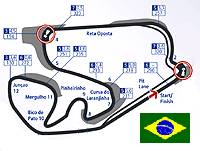 Interlagos may be one of the shorter laps on the calendar at just over 2.66 miles, but there's no shortage of challenges for the drivers and engineers. With one of the longest straights of the season, combined with slow hairpins and a couple of high-speed corners, finding the sweet spot at Interlagos is all about making the right set-up compromise.
Interlagos may be one of the shorter laps on the calendar at just over 2.66 miles, but there's no shortage of challenges for the drivers and engineers. With one of the longest straights of the season, combined with slow hairpins and a couple of high-speed corners, finding the sweet spot at Interlagos is all about making the right set-up compromise.
The perennial question facing teams at the Brazilian Grand Prix is whether to choose straight-line speed over optimum lap time. It's a challenge that has been made easier this year thanks to the wonders of the f-duct, but it's still front-of-mind for the engineers, as Renault chief engineer Alan Permane explains: "We usually set the car up to achieve the optimum lap time, and the way the R30 works with our f-duct should still allow us to achieve good straight-line speeds. It means we can have the downforce in the slow infield corners but still be competitive enough to attack or defend down the straights."
Finding the sweet spot for the mechanical set-up is a similar story with a balance necessary to deliver a car that works well in the low and high-speed sections. "As always, it's the low-speed corners where the most lap time can be found, so it's important that your car has good traction," he continues. "But with high-speed corners such as turn 11, which has an apex speed of 230 km/h, the car needs to be responsive and you can't afford to have a set-up that is too soft. As ever, it's about striking the right balance."
It's those quick corners with the high g-forces that make Interlagos a tough race physically for the drivers. The forces are highest in turns six and seven where the drivers have to endure 4.5g of lateral acceleration for 4.5 seconds. The anti-clockwise layout also subjects the drivers' necks to the opposite loadings experienced at clockwise circuits for many of the corners. As a result, don't be surprised to see extra cockpit padding appear on the drivers' headrests to help them through the 71 laps of the Grand Prix.
On the engine side, the long main straight means that engine power is a critical factor at Interlagos with the cars on full throttle for 16 seconds from the exit of turn 12 until the braking zone for turn one. On top of that, all the engines must cope with the effect of running at altitude because the circuit is situated around 800 metres above sea level.
"Running at altitude costs an F1 engine around 8% of its power," adds Remi Taffin, head of engine track operations at Renault. "Despite losing this power, the altitude actually has a positive impact on the engine because the moving parts suffer less. There is less air entering the engine, which means less pressure and less stress on the pistons, conrods, crankshaft and every moving part."
The engine engineers will also work hard over the weekend to deliver engine mapping that gives the engine good torque delivery, especially at low revs. "There are a couple of tricky low speed corners so the engine needs to be drivable at the lower end of the rev range from 8,000 to 13,000 rpm," says Taffin. "Getting smooth power delivery will help to ensure a stable car balance and good performance through the twisty middle sector."
The final challenge of the lap is the long left-hand drag up the hill onto the main straight, which can make it tricky to pick up the last bit of fuel in the tank, especially during low-fuel qualifying runs. "We will need to check the fuel pick-up in free practice," explains Taffin. "We don't expect any problems with the fuel system we have been running, but it's better to be safe than sorry."

 Interlagos may be one of the shorter laps on the calendar at just over 2.66 miles, but there's no shortage of challenges for the drivers and engineers. With one of the longest straights of the season, combined with slow hairpins and a couple of high-speed corners, finding the sweet spot at Interlagos is all about making the right set-up compromise.
Interlagos may be one of the shorter laps on the calendar at just over 2.66 miles, but there's no shortage of challenges for the drivers and engineers. With one of the longest straights of the season, combined with slow hairpins and a couple of high-speed corners, finding the sweet spot at Interlagos is all about making the right set-up compromise.



















sign in